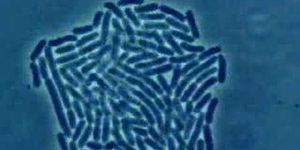Videos
Bacteria Growing
SEP 09, 2014 12:00 AM PDT
Share
City Spiders are Living Large
 As more of the natural environment is lost to development, some species suffer, but others thrive even as biodiversity decreases. These successful "urban exploiters" include such animals as pigeons and raccoons. But, these animals are relatively large and mobile and a team of researchers from the University of Sydney wanted to see how the urbanization effect played out on a smaller scale, so they took a look at how the golden orb-weaving spider, Nephila plumipes, fared in Sydney, Australia's largest city. This spider, which is abundant along the east coast of Australia, builds semi-permanent webs which they remain in for life. This non-mobile lifestyle makes the species an ideal one to use in studying the effects of microhabitat on their condition. The results of this research, appearing in PLOS ONE shows that these city-dwelling spiders are larger and carry more eggs than their country cousins.
As more of the natural environment is lost to development, some species suffer, but others thrive even as biodiversity decreases. These successful "urban exploiters" include such animals as pigeons and raccoons. But, these animals are relatively large and mobile and a team of researchers from the University of Sydney wanted to see how the urbanization effect played out on a smaller scale, so they took a look at how the golden orb-weaving spider, Nephila plumipes, fared in Sydney, Australia's largest city. This spider, which is abundant along the east coast of Australia, builds semi-permanent webs which they remain in for life. This non-mobile lifestyle makes the species an ideal one to use in studying the effects of microhabitat on their condition. The results of this research, appearing in PLOS ONE shows that these city-dwelling spiders are larger and carry more eggs than their country cousins. Lizzy Lowe, a graduate student in ecology and lead author of the paper, and her colleagues collected 222 spiders from 20 sites around Sydney. The size of the spiders was determined by measuring leg length, tibia length, carapace length/width, and abdomen length, width and height. To gauge fertility they measured the ovary and lipid weight in 29 spiders.
The sites differed in their degrees of urbanization. They were classified into three main landscape types -- recreational parks and gardens, remnant patches, and continuous bushland. The park/garden sites were typically surrounded by housing and consisted of grass, non-native vegetation, buildings and hard surfaces. The remnants were patches of native vegetation predominantly surrounded by housing. The continuous bushland sites consisted mostly of native vegetation connected to large natural areas of bushland.
Lowe evaluated the degree of urbanization of each site based on the amount of vegetation covering the land, distance from the city center and socioeconomic information such as income and population density. Integrating this data with the spider measurements she looked for patterns, finding that in areas with less vegetation and more hard surfaces such as sidewalks and walls, the spiders were larger and carried more eggs.
There are several possible reasons for these findings. Hard surfaces retain heat. The increase in temperature may mean the spiders use less energy trying to keep warm, helping them grow. They also may have more to eat in these areas. At night artificial light attracts beetles, flies and moths that the spiders can eat. The larger spiders with bigger ovaries were also found in densely populated high-income suburbs, leading the researchers to suggest that these areas may provide more trash, producing more prey for the spiders to eat. Also, the urban spiders may be dealing with fewer predators and parasites. For example, smaller dewdrop spiders steal prey and webs from the orb-weaving spiders. Lowe's team found fewer of these "kleptoparasites" at the more urbanized sites.
If you're an arachnophobe, you might think that bigger, healthier spiders are a bad thing, but they're not. Lowe, and another study author, Dieter F. Hochuli, an associate professor at the University of Sydney write in The Conversation, "Understanding the effects of urbanization on wildlife is essential for the maintenance of biodiversity in cities. Having native plants and animals in our cities is not just important for conservation, it's also essential for human health and education."
So, the fact that some spiders are loving cities is cause for hope. In order to maintain biodiversity in cities we need to be able to support more diverse populations of spiders and other invertebrates. The authors say, "By gaining a better understanding of the impacts of urbanization on wildlife in cities we can work towards creating healthy, functioning ecosystems in urban areas."
Sponsored by

You May Also Like
Loading Comments...








